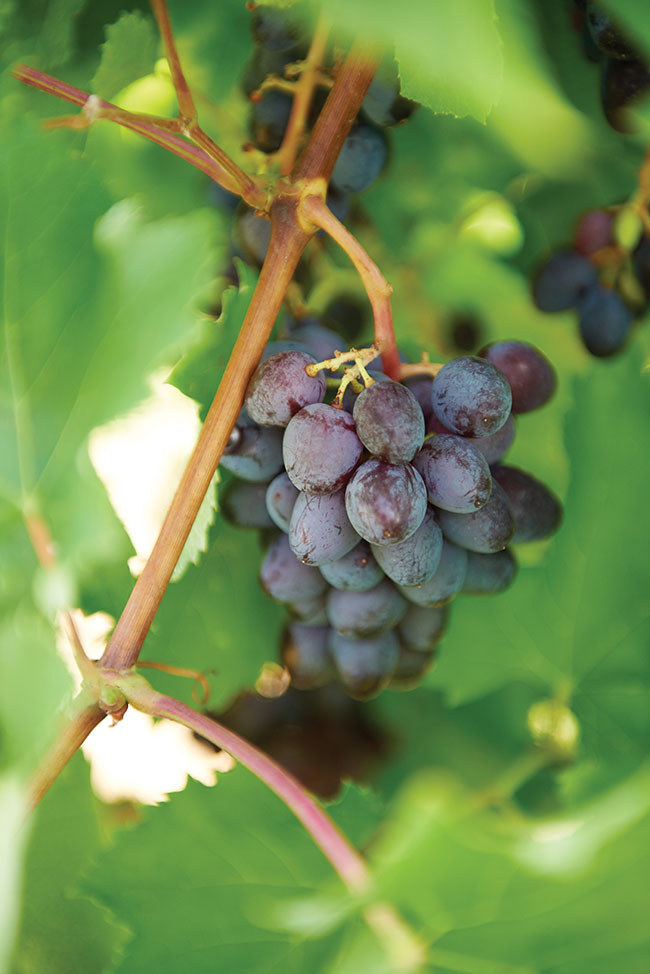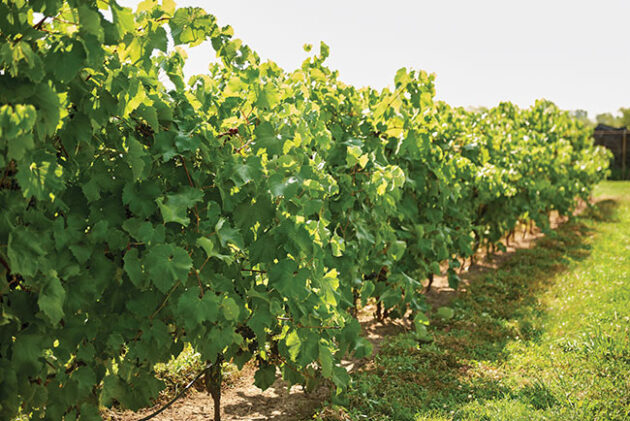
Features
Research
Ontario fruit industry invests in table grapes
Jupiter is the first variety since Sovereign Coronation to make a foothold in the province.
January 31, 2023 By Julienne Isaacs
 Jupiter, a seedless blue variety, has shown excellent winter hardiness.
Photos courtesy of Vineland Research and Innovation Centre.
Jupiter, a seedless blue variety, has shown excellent winter hardiness.
Photos courtesy of Vineland Research and Innovation Centre.
One thing is clear: Canadians love grapes.
According to Statistics Canada, grapes are the top-imported fruit, followed by bananas and strawberries; in 2020, Canada imported over $685 million worth of grapes, primarily from the United States and Mexico.
In contrast, a very small amount of grapes are produced domestically, says Sarah Marshall, manager of both Ontario Tender Fruit Growers and Ontario Fresh Grape Growers. This is due to a whole host of factors, including the challenge of finding winter-hardy varieties, the extensive testing time required for imported vines, the cost of land and labour shortages.
Since its development in the 1970s by Agriculture and Agri-Food Canada in B.C., a single table grape offering – Sovereign Coronation, a semi-seedless blue-purple hybrid grape variety – has ruled the domestic industry.
Based on this one domestic table grape, the industry is worth $4 million in growth, Marshall says. Given a chance, she adds, “it could be 20 million.”
Ten years ago, the Ontario Fresh Grape Growers’ marketing board began a partnership with Vineland Research and Innovation Centre (Vineland), with funding from the Ontario Ministry of Agriculture, Food and Rural Affairs (OMAFRA) and a range of industry partners, to try to develop domestic contenders in multiple table grape categories.
Enter Jupiter, a blue, seedless grape developed at the University of Arkansas in the 1990s, which was first planted at Vineland in 2014. The variety has shown excellent winter hardiness, a prerequisite for the Ontario market, and it matures after Sovereign Coronation, extending the harvesting season.
“Sovereign Coronation has a six- to eight-week season, with harvest, picking, packing and shipping all occurring between late August and early September,” says Michael Kauzlaric, technology scout and grower outreach for Vineland. “Extending the season benefits the entire industry, including harvesting crews.”
Jupiter is now being commercially planted in small amounts in Ontario – “enough to start making an impact in the marketplace,” Kauzlaric says.
There’s more growth in store for table grapes in Canada.
“The industry has always had an appetite for finding a new variety or new varieties as consumers’ tastes have changed and the marketplace has changed over time,” Kauzlaric says. But adding new grapes to commercial growers’ fields is tougher than it seems.

Jupiter is now being commercially planted in small amounts in Ontario.
Challenges
The path to importing new table grape varieties is long and complex. It’s not just a matter of importing, planting and testing vines in the field, Marshall says.
New vines come in soil-free and must be tested for at least three or four years for viruses that might be hitching a ride in plant material. Once planted in experimental test blocks, vines must pass basic quality parameter checks and survive multiple winters.
“With climate change, things that were considered winter hardy [in the past] might not be anymore,” Marshall says. “If that warm temperature in December decides four weeks later that it’ll be minus 22 degrees, the vine hasn’t had time to de-acclimate. Each fluctuation messes up the grapes’ sleep.” In the field, the typical lifespan for a grapevine is around 15 years; it takes time to evaluate whether new vines are likely to last that long.
Commercial growers are unlikely to take a risk on untested material, so the more experimental sites in a range of locations and conditions, the better, Marshall adds. But it takes time to build up enough plant material that commercial orders for vines can be filled.
But it’s not just survival that Vineland and its partners are looking for. The grapes must have consumer appeal and meet a long list of quality parameters.
When the Ontario Fresh Grape Growers’ marketing board began its partnership with Vineland a decade ago, they identified several gaps in the domestic market, including seedless green and red grapes, which weren’t produced commercially at all.
“[Seedless green grapes] come in [to Canada] in millions and millions of pounds from importing countries, and we’re missing an opportunity on a seedless green because we don’t have one,” Marshall says. “There’s a real opportunity for import replacement with local.”
In 2014, the partnership brought in varieties from a European table grape developer called SNFL Group. These varieties are finally through the virus-testing phase and were planted in test blocks last year, she says.
At Vineland and a few commercial sites, 11 new varieties are currently being tested in experimental blocks on two different rootstocks; half of them fruited in 2022.
“Ever since 2014, there’s been an annual evaluation,” Kauzlaric explains. “Some varieties were planted in 2014 and by 2018, 2019, [we saw fruit]. Some varieties that were planted in 2014 were torn out in 2019, because the fruit quality wasn’t meeting industry expectations and there was some winter damage.”
Vineland is testing a rainbow of grape colours; its consumer sensory research team has identified that there’s room for expansion of the colour range.
One green seedless variety, which Kauzlaric can’t identify yet, showed a lot of promise this year. “We hope to work to an agreement this winter that will allow for further testing and expansion of that variety in different areas in Canada and put them on different grower sites, to get a sense of how they’ll perform,” he says.
It might take a little while before consumers can taste the results of these trials and pack them in school lunchboxes. But the future looks sweet.
Print this page